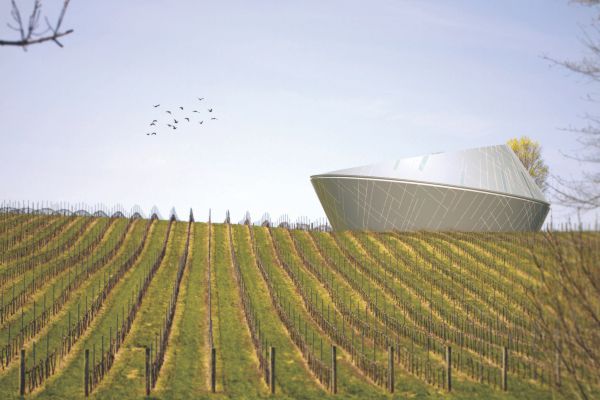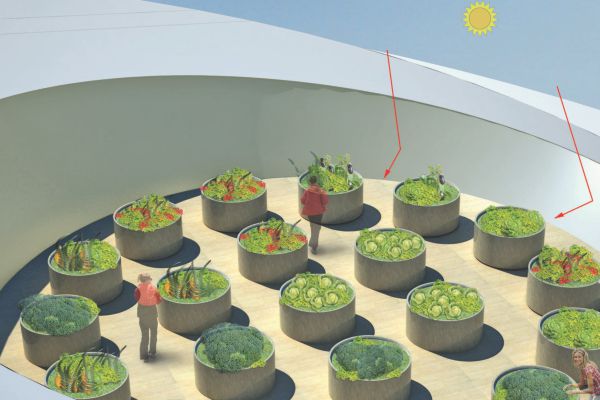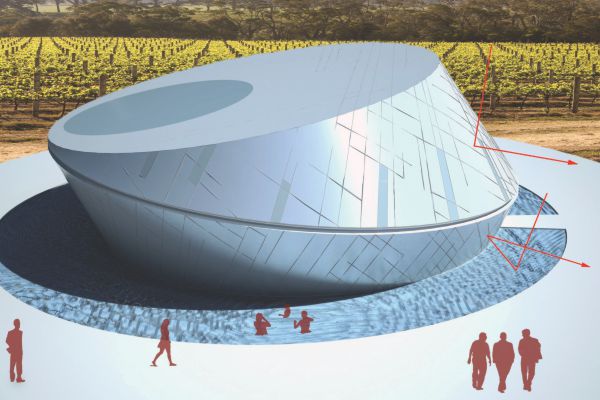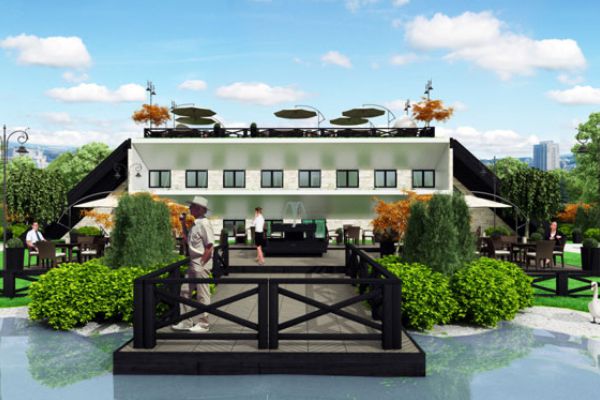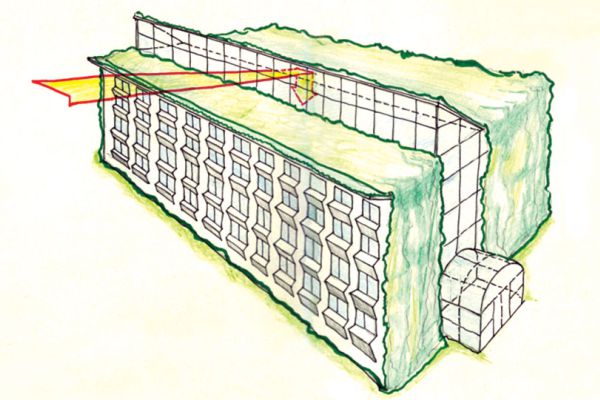Sustainable farm = lower production costs
Earth-covered facilities with reflective surfaces are particularly aceptable for any form of animal breeding and plant grow, and the increase in heat of the layers enables enormous savings in food production. Reflective surfaces (shiny foils and solid based coatings) are the cheapest source of energy, simultaneously harvesting heat and light.
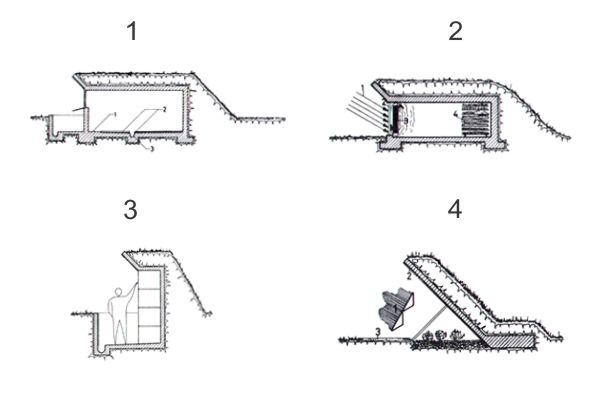
Self-heating ecological house as an agricultural eco-building: 1. A large farm for large animals; 2. Self-heating ecological house as an agricultural eco-building with Thrombe's wall or curtain: mushroom growing, californian earthworms grownig, etc; 3. Multi-level small animals farming; 4. Earth-protected greenhouse with reflective surfaces.
Domestic animal barns can be constructed using the principle of self-heating eco-houses, because the concept enables more favorable temperatures which, in terms, increases considerably higher productivity rate in food production. Earth-covered facilities can be assimilated for the purpose of domestic and other animals breeding and heating costs can be reduced by using free solar energy, harvested with reflective surfaces implementation.
Reflective surfaces can also be installed in green houses in order to speed up the growth and maturing of plants (picture 1). Apart from the use in growing plants, this principle can also be implemented in mushroom growing, water desalinisation or waste water distilling.
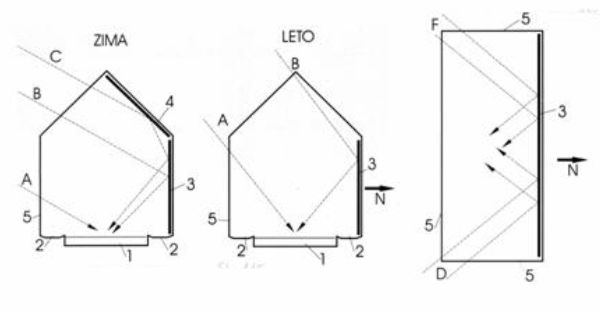
Green house with reflective surfaces during winter and summer:A – direct sun radiation, B – reflected radiation, C – double reflection; 1 – plant floor or seawater pool, 2 – condensate collecting ducts, 3 – lower reflective surface, 4 – upper reflective surface, 5 – glass or plastic surfaces; Horisontal cross section of the green house with reflective surfaces: D – direct and reflected radiation of sunbeams before noon, F - direct and reflected radiation of sunbeams in the afternoon, 5 – transparent surfaces (glass, plastic), 3 – reflective surface
Thermal effect is achieved thru reduced heat loss on the north side, resulted by the reflective surfaces installation, which in terms doubles the the thermal isolation in a cheapest way possible.
Implementation: agricultural eco-buildings, eco-stables for large and small animals; small farms for birds, rabbits, bees; mushroom cultivation, californian earthworms cultivation i sl.; drying rooms, food storages and warehouses; complete farms, economies and agricultural households based on the concept of self-heating eco-house, etc.
Areas: agriculture, livestock, ecology, construction
Discipline: ecological architecture, sustainable agriculture and livestock, energy efficiency, renewable energy sources
The winery project - Passivne solar architecture
The winery project, based upon the concept od self-heating ecological house, was developed in 2011. by architect Slaven Stevanović during his studies od arhitecture at The Department for ahitecture nd civil construction, University of Novi Sad, Republic of Serbia. During the process of design architect Stevanović consulted with academician Veljko Milković and this project is one of the most representative examples on the succesfull implementation of reflective surfaces in modern concepts of passive solar arhtecture
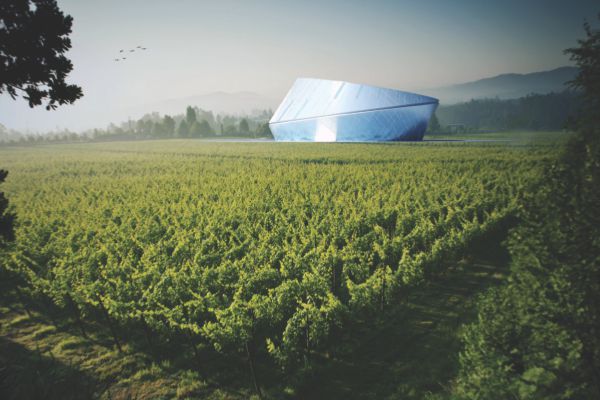
The problem
1. Design a building that could, aside from its required function and distinctive production process, offer something more than just be "a production box"
2. Can arhitecture influence the quality of the production and contribute to the quality of the building at the same time?
Proposed solution
- This concept is based on the fact that the quality and quantity of the wine and vineyard are the most important factors in wine production. Higher temperatures and water proximity are the vital elements if the expected level of quantity and quality of the wine is to be achieved.
- Reflective surfaces as the means of passive solar arhitecture are used in order to gain additional amounts of heat. This concept was patented by academician Veljko Milković as a part of self-heating ecologicl house concept.
- Properly used, with additional elements of passive solar arhitecture, reflective surfaces can accomplish up to 85% savings in heating costs. If we rotate the process and heat ethe exterior surroundings (vineyard) instead of enterior of the building, it is safe to assume that heat increase in the vineyard will be achieved.
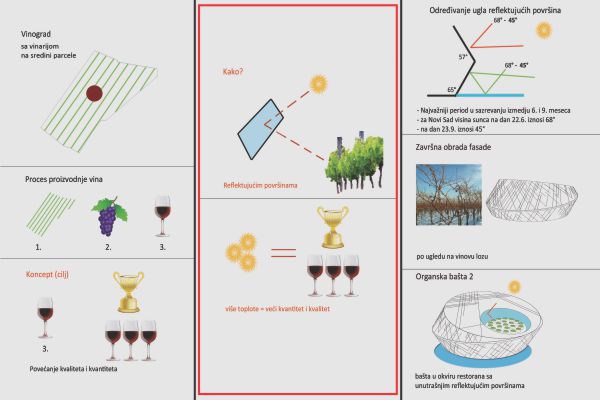
- Geometric analisys of solar radiation at the Novi Sad surrounding area was used to determin the angle of refletive surface on the fcade of the building and the the water surface surrounding the building doubles its use as an adittional reflective surface of natural origin.
- The presence of water surrounding the building can be used for heating, but also as a swimming pool for guest visitors of the winery, expanding its use to tourism.
- The wall filling shold be done with the use of ecological materials, such as pressed straw bales.
Exterior
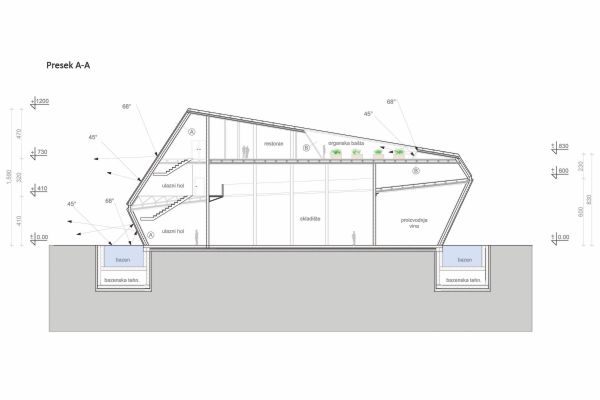
A Reflective surfaces: Stainless steel plates - 2,5cm; Air layer - 5-16cm; Steel construction; Clay mortar - 2,5cm; T.i. - pressed straw bales - 35cm; Clay mortar - 2,5cm; Gypsum cardboard boards - 2cm; B Reflective surfaces: Air layer - 5cm; Gypsum cardboard boards - 2cm
Other self-heating concepts
Business facilities
Public buildings, corporate offices, restaurants


